Economic Assignment on Rationality, Incentives, and Income Elasticity
VerifiedAdded on 2021/04/16
|9
|1401
|21
Homework Assignment
AI Summary
This economics assignment explores fundamental economic principles, beginning with the assumption of rationality in decision-making. It examines how individuals make optimal choices by conducting cost-benefit analyses and responding to economic incentives. The assignment then delves into the concept of income elasticity of demand, defining it as the percentage change in quantity demanded in response to a percentage change in income. It categorizes products based on their income elasticity, including necessary goods (income inelastic), luxury goods (income elastic), and inferior goods (negative income elasticity). The assignment also discusses the determinants of income elasticity, such as the nature of the commodity, time, variety of use, and distribution of wealth. These factors influence how demand changes in response to income fluctuations, providing a comprehensive overview of consumer behavior and market dynamics.
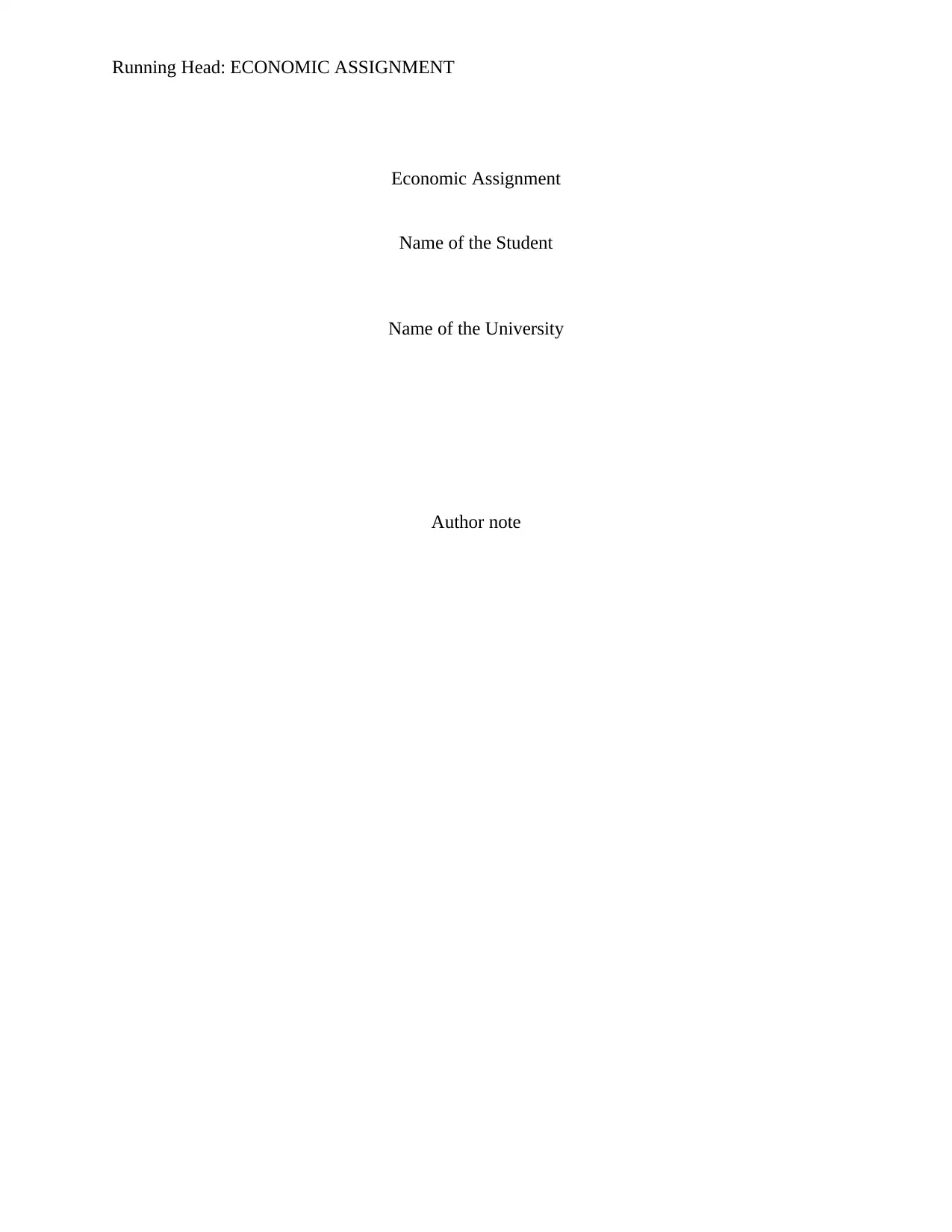
Running Head: ECONOMIC ASSIGNMENT
Economic Assignment
Name of the Student
Name of the University
Author note
Economic Assignment
Name of the Student
Name of the University
Author note
Paraphrase This Document
Need a fresh take? Get an instant paraphrase of this document with our AI Paraphraser
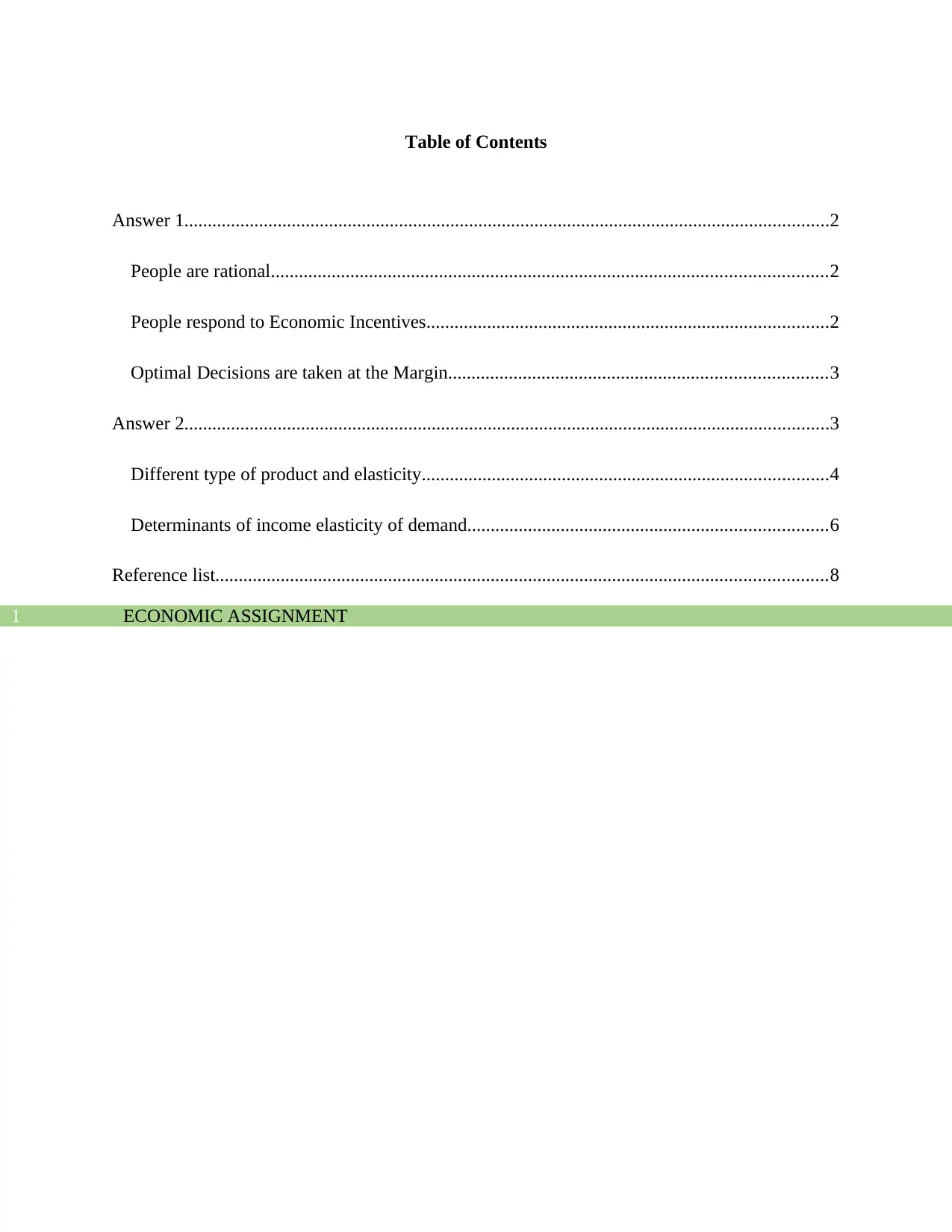
ECONOMIC ASSIGNMENT1
Table of Contents
Answer 1..........................................................................................................................................2
People are rational.......................................................................................................................2
People respond to Economic Incentives......................................................................................2
Optimal Decisions are taken at the Margin.................................................................................3
Answer 2..........................................................................................................................................3
Different type of product and elasticity.......................................................................................4
Determinants of income elasticity of demand.............................................................................6
Reference list...................................................................................................................................8
Table of Contents
Answer 1..........................................................................................................................................2
People are rational.......................................................................................................................2
People respond to Economic Incentives......................................................................................2
Optimal Decisions are taken at the Margin.................................................................................3
Answer 2..........................................................................................................................................3
Different type of product and elasticity.......................................................................................4
Determinants of income elasticity of demand.............................................................................6
Reference list...................................................................................................................................8
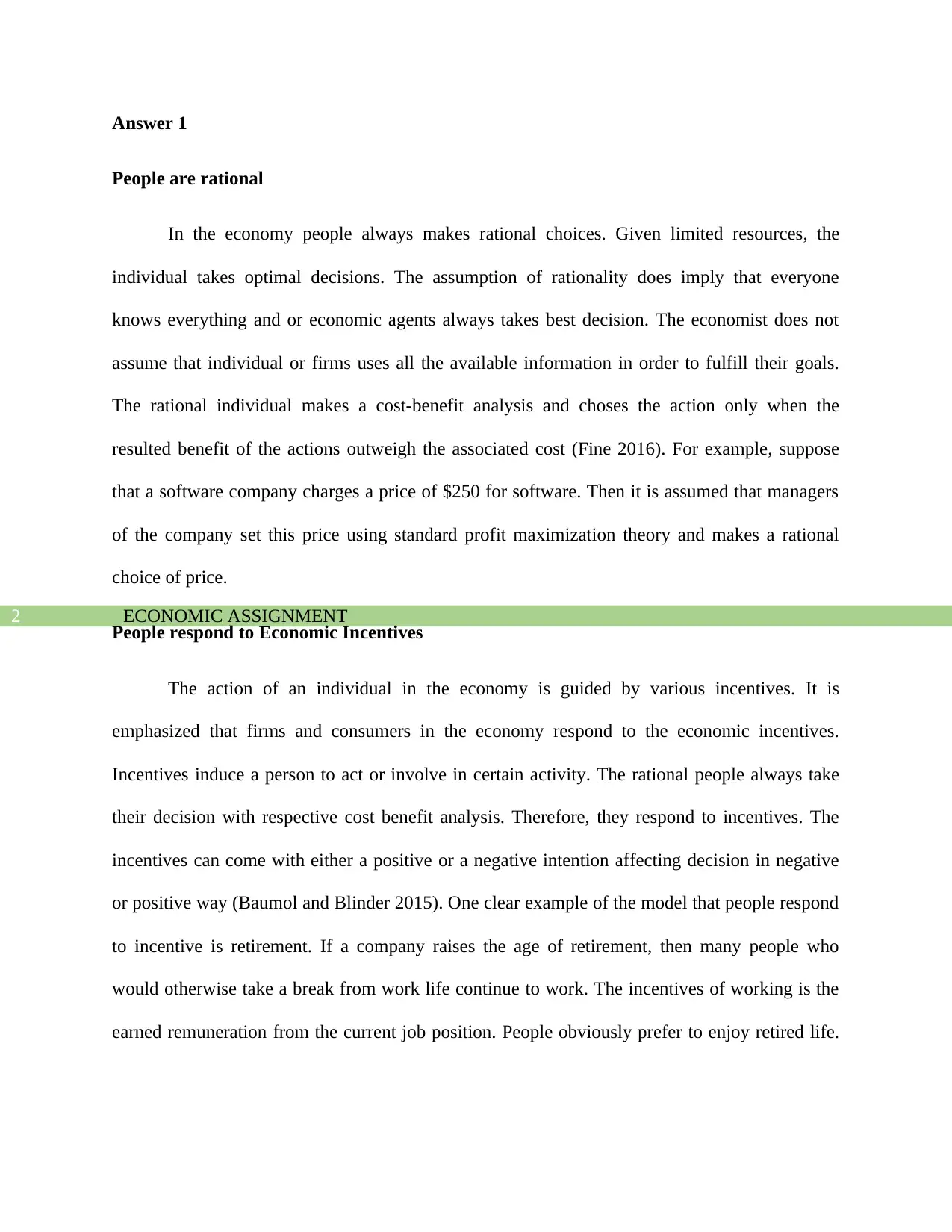
ECONOMIC ASSIGNMENT2
Answer 1
People are rational
In the economy people always makes rational choices. Given limited resources, the
individual takes optimal decisions. The assumption of rationality does imply that everyone
knows everything and or economic agents always takes best decision. The economist does not
assume that individual or firms uses all the available information in order to fulfill their goals.
The rational individual makes a cost-benefit analysis and choses the action only when the
resulted benefit of the actions outweigh the associated cost (Fine 2016). For example, suppose
that a software company charges a price of $250 for software. Then it is assumed that managers
of the company set this price using standard profit maximization theory and makes a rational
choice of price.
People respond to Economic Incentives
The action of an individual in the economy is guided by various incentives. It is
emphasized that firms and consumers in the economy respond to the economic incentives.
Incentives induce a person to act or involve in certain activity. The rational people always take
their decision with respective cost benefit analysis. Therefore, they respond to incentives. The
incentives can come with either a positive or a negative intention affecting decision in negative
or positive way (Baumol and Blinder 2015). One clear example of the model that people respond
to incentive is retirement. If a company raises the age of retirement, then many people who
would otherwise take a break from work life continue to work. The incentives of working is the
earned remuneration from the current job position. People obviously prefer to enjoy retired life.
Answer 1
People are rational
In the economy people always makes rational choices. Given limited resources, the
individual takes optimal decisions. The assumption of rationality does imply that everyone
knows everything and or economic agents always takes best decision. The economist does not
assume that individual or firms uses all the available information in order to fulfill their goals.
The rational individual makes a cost-benefit analysis and choses the action only when the
resulted benefit of the actions outweigh the associated cost (Fine 2016). For example, suppose
that a software company charges a price of $250 for software. Then it is assumed that managers
of the company set this price using standard profit maximization theory and makes a rational
choice of price.
People respond to Economic Incentives
The action of an individual in the economy is guided by various incentives. It is
emphasized that firms and consumers in the economy respond to the economic incentives.
Incentives induce a person to act or involve in certain activity. The rational people always take
their decision with respective cost benefit analysis. Therefore, they respond to incentives. The
incentives can come with either a positive or a negative intention affecting decision in negative
or positive way (Baumol and Blinder 2015). One clear example of the model that people respond
to incentive is retirement. If a company raises the age of retirement, then many people who
would otherwise take a break from work life continue to work. The incentives of working is the
earned remuneration from the current job position. People obviously prefer to enjoy retired life.
⊘ This is a preview!⊘
Do you want full access?
Subscribe today to unlock all pages.

Trusted by 1+ million students worldwide
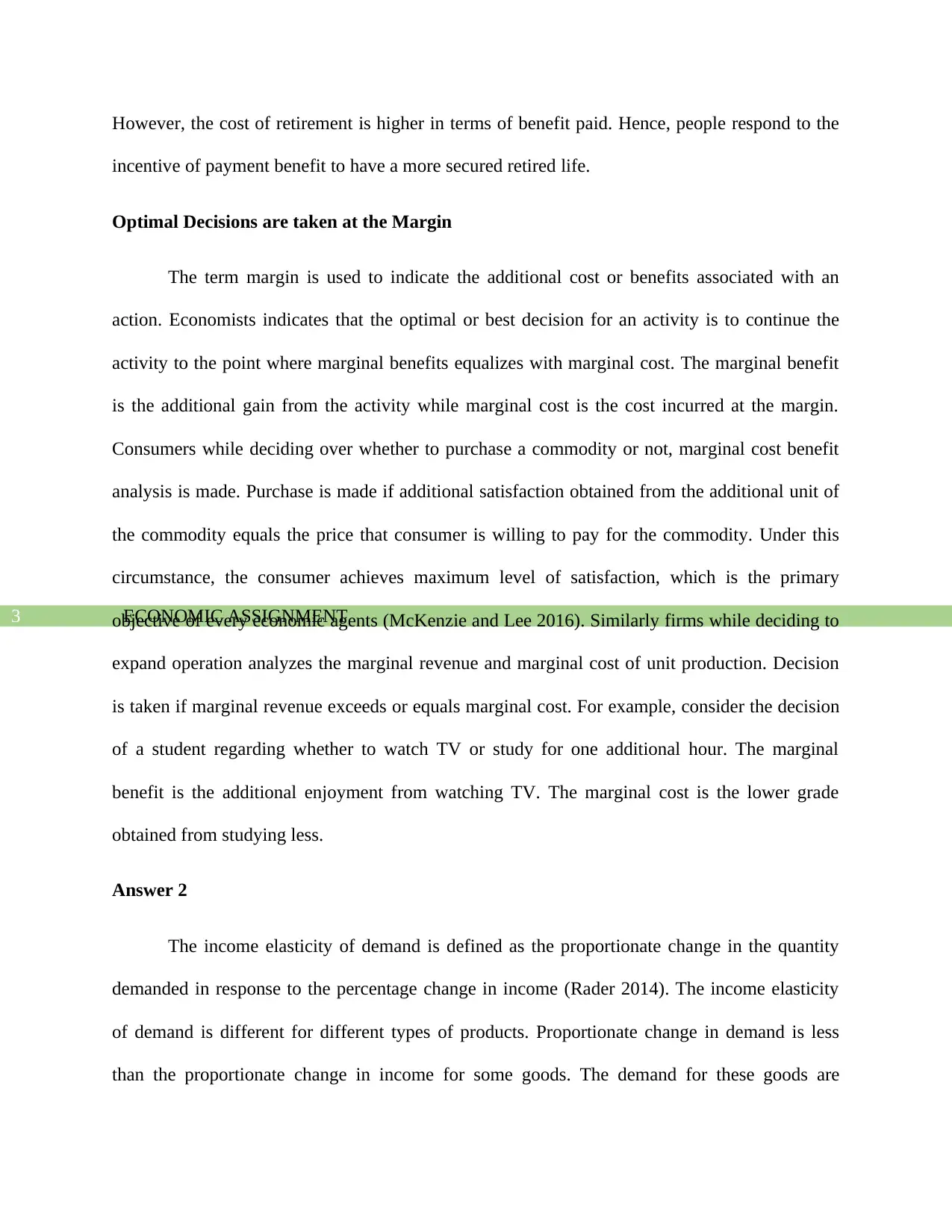
ECONOMIC ASSIGNMENT3
However, the cost of retirement is higher in terms of benefit paid. Hence, people respond to the
incentive of payment benefit to have a more secured retired life.
Optimal Decisions are taken at the Margin
The term margin is used to indicate the additional cost or benefits associated with an
action. Economists indicates that the optimal or best decision for an activity is to continue the
activity to the point where marginal benefits equalizes with marginal cost. The marginal benefit
is the additional gain from the activity while marginal cost is the cost incurred at the margin.
Consumers while deciding over whether to purchase a commodity or not, marginal cost benefit
analysis is made. Purchase is made if additional satisfaction obtained from the additional unit of
the commodity equals the price that consumer is willing to pay for the commodity. Under this
circumstance, the consumer achieves maximum level of satisfaction, which is the primary
objective of every economic agents (McKenzie and Lee 2016). Similarly firms while deciding to
expand operation analyzes the marginal revenue and marginal cost of unit production. Decision
is taken if marginal revenue exceeds or equals marginal cost. For example, consider the decision
of a student regarding whether to watch TV or study for one additional hour. The marginal
benefit is the additional enjoyment from watching TV. The marginal cost is the lower grade
obtained from studying less.
Answer 2
The income elasticity of demand is defined as the proportionate change in the quantity
demanded in response to the percentage change in income (Rader 2014). The income elasticity
of demand is different for different types of products. Proportionate change in demand is less
than the proportionate change in income for some goods. The demand for these goods are
However, the cost of retirement is higher in terms of benefit paid. Hence, people respond to the
incentive of payment benefit to have a more secured retired life.
Optimal Decisions are taken at the Margin
The term margin is used to indicate the additional cost or benefits associated with an
action. Economists indicates that the optimal or best decision for an activity is to continue the
activity to the point where marginal benefits equalizes with marginal cost. The marginal benefit
is the additional gain from the activity while marginal cost is the cost incurred at the margin.
Consumers while deciding over whether to purchase a commodity or not, marginal cost benefit
analysis is made. Purchase is made if additional satisfaction obtained from the additional unit of
the commodity equals the price that consumer is willing to pay for the commodity. Under this
circumstance, the consumer achieves maximum level of satisfaction, which is the primary
objective of every economic agents (McKenzie and Lee 2016). Similarly firms while deciding to
expand operation analyzes the marginal revenue and marginal cost of unit production. Decision
is taken if marginal revenue exceeds or equals marginal cost. For example, consider the decision
of a student regarding whether to watch TV or study for one additional hour. The marginal
benefit is the additional enjoyment from watching TV. The marginal cost is the lower grade
obtained from studying less.
Answer 2
The income elasticity of demand is defined as the proportionate change in the quantity
demanded in response to the percentage change in income (Rader 2014). The income elasticity
of demand is different for different types of products. Proportionate change in demand is less
than the proportionate change in income for some goods. The demand for these goods are
Paraphrase This Document
Need a fresh take? Get an instant paraphrase of this document with our AI Paraphraser
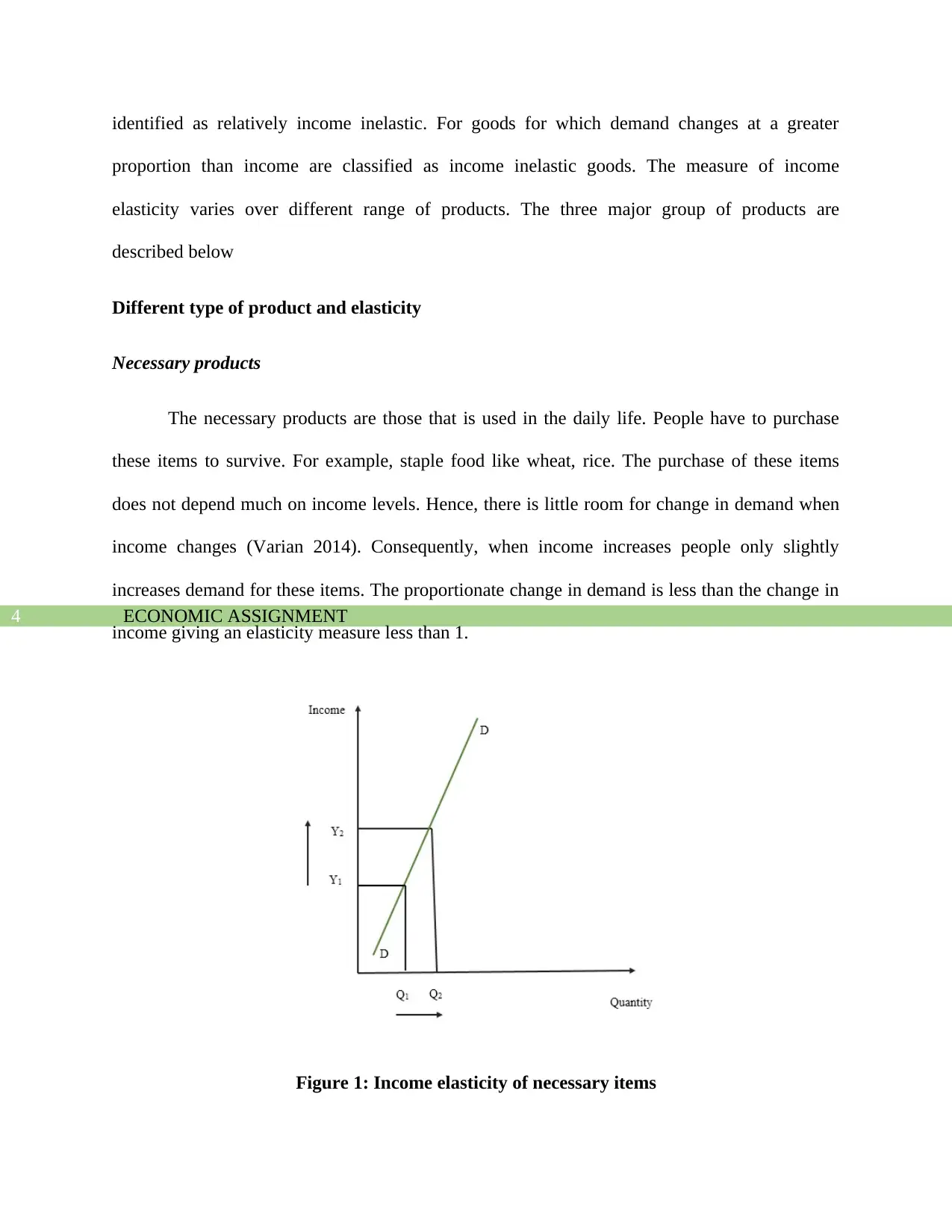
ECONOMIC ASSIGNMENT4
identified as relatively income inelastic. For goods for which demand changes at a greater
proportion than income are classified as income inelastic goods. The measure of income
elasticity varies over different range of products. The three major group of products are
described below
Different type of product and elasticity
Necessary products
The necessary products are those that is used in the daily life. People have to purchase
these items to survive. For example, staple food like wheat, rice. The purchase of these items
does not depend much on income levels. Hence, there is little room for change in demand when
income changes (Varian 2014). Consequently, when income increases people only slightly
increases demand for these items. The proportionate change in demand is less than the change in
income giving an elasticity measure less than 1.
Figure 1: Income elasticity of necessary items
identified as relatively income inelastic. For goods for which demand changes at a greater
proportion than income are classified as income inelastic goods. The measure of income
elasticity varies over different range of products. The three major group of products are
described below
Different type of product and elasticity
Necessary products
The necessary products are those that is used in the daily life. People have to purchase
these items to survive. For example, staple food like wheat, rice. The purchase of these items
does not depend much on income levels. Hence, there is little room for change in demand when
income changes (Varian 2014). Consequently, when income increases people only slightly
increases demand for these items. The proportionate change in demand is less than the change in
income giving an elasticity measure less than 1.
Figure 1: Income elasticity of necessary items
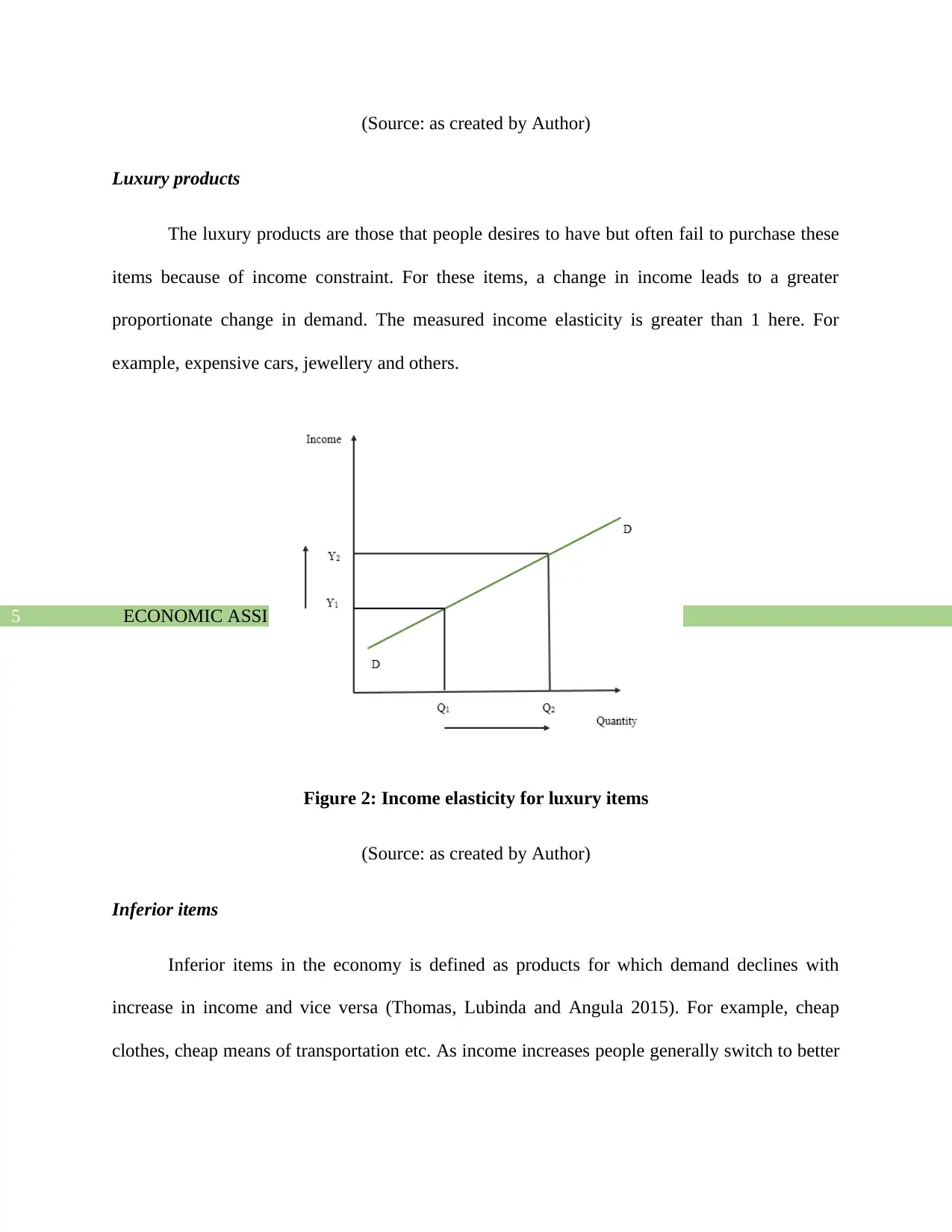
ECONOMIC ASSIGNMENT5
(Source: as created by Author)
Luxury products
The luxury products are those that people desires to have but often fail to purchase these
items because of income constraint. For these items, a change in income leads to a greater
proportionate change in demand. The measured income elasticity is greater than 1 here. For
example, expensive cars, jewellery and others.
Figure 2: Income elasticity for luxury items
(Source: as created by Author)
Inferior items
Inferior items in the economy is defined as products for which demand declines with
increase in income and vice versa (Thomas, Lubinda and Angula 2015). For example, cheap
clothes, cheap means of transportation etc. As income increases people generally switch to better
(Source: as created by Author)
Luxury products
The luxury products are those that people desires to have but often fail to purchase these
items because of income constraint. For these items, a change in income leads to a greater
proportionate change in demand. The measured income elasticity is greater than 1 here. For
example, expensive cars, jewellery and others.
Figure 2: Income elasticity for luxury items
(Source: as created by Author)
Inferior items
Inferior items in the economy is defined as products for which demand declines with
increase in income and vice versa (Thomas, Lubinda and Angula 2015). For example, cheap
clothes, cheap means of transportation etc. As income increases people generally switch to better
⊘ This is a preview!⊘
Do you want full access?
Subscribe today to unlock all pages.

Trusted by 1+ million students worldwide
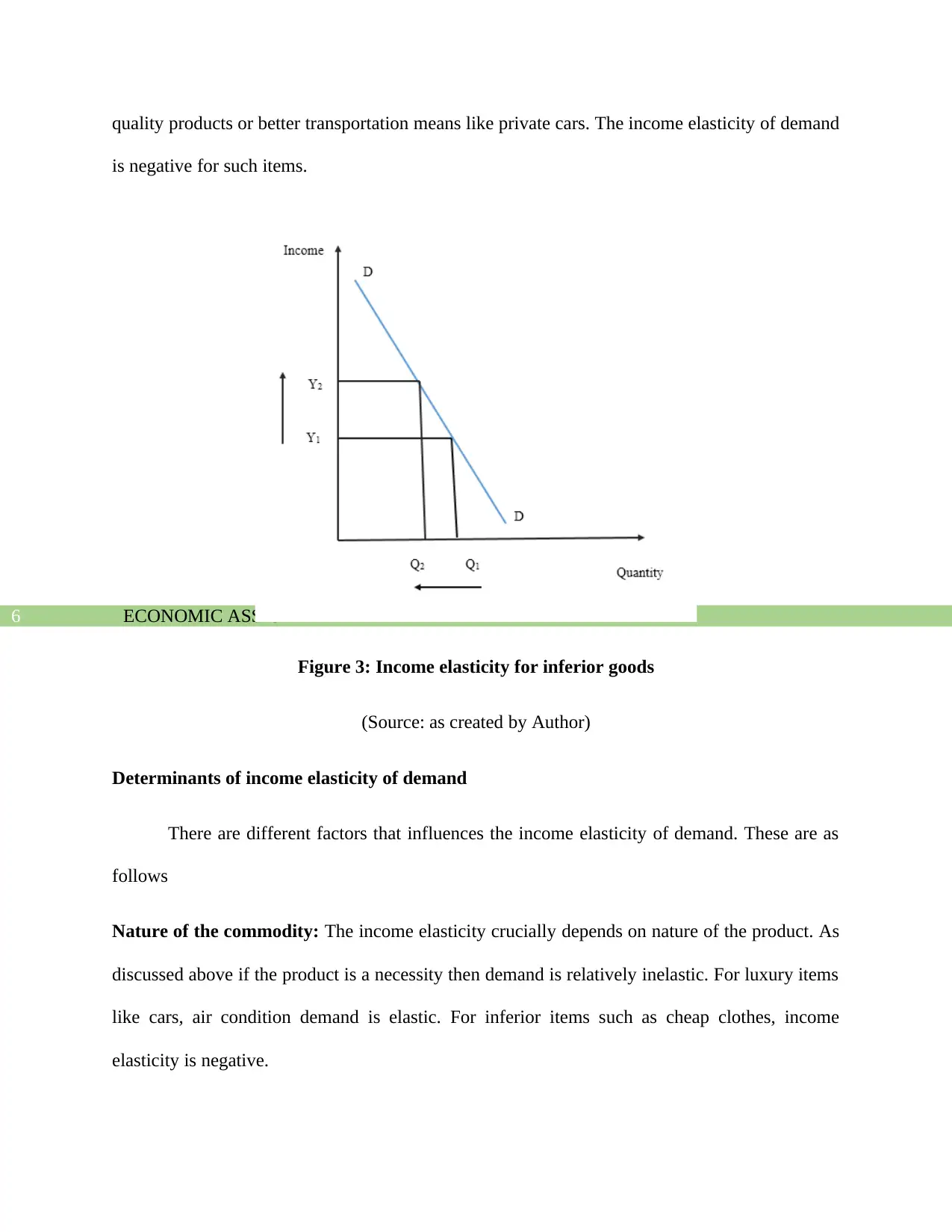
ECONOMIC ASSIGNMENT6
quality products or better transportation means like private cars. The income elasticity of demand
is negative for such items.
Figure 3: Income elasticity for inferior goods
(Source: as created by Author)
Determinants of income elasticity of demand
There are different factors that influences the income elasticity of demand. These are as
follows
Nature of the commodity: The income elasticity crucially depends on nature of the product. As
discussed above if the product is a necessity then demand is relatively inelastic. For luxury items
like cars, air condition demand is elastic. For inferior items such as cheap clothes, income
elasticity is negative.
quality products or better transportation means like private cars. The income elasticity of demand
is negative for such items.
Figure 3: Income elasticity for inferior goods
(Source: as created by Author)
Determinants of income elasticity of demand
There are different factors that influences the income elasticity of demand. These are as
follows
Nature of the commodity: The income elasticity crucially depends on nature of the product. As
discussed above if the product is a necessity then demand is relatively inelastic. For luxury items
like cars, air condition demand is elastic. For inferior items such as cheap clothes, income
elasticity is negative.
Paraphrase This Document
Need a fresh take? Get an instant paraphrase of this document with our AI Paraphraser
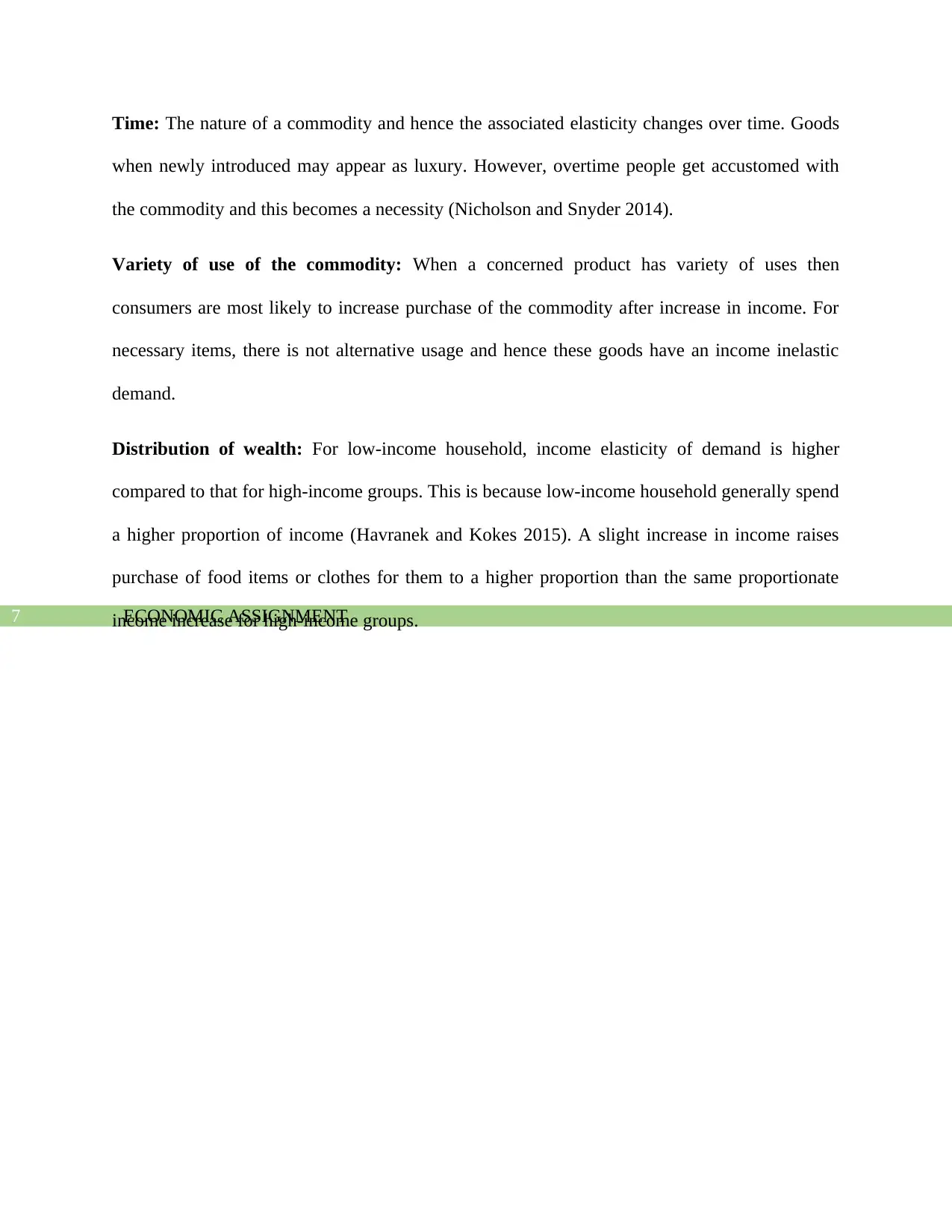
ECONOMIC ASSIGNMENT7
Time: The nature of a commodity and hence the associated elasticity changes over time. Goods
when newly introduced may appear as luxury. However, overtime people get accustomed with
the commodity and this becomes a necessity (Nicholson and Snyder 2014).
Variety of use of the commodity: When a concerned product has variety of uses then
consumers are most likely to increase purchase of the commodity after increase in income. For
necessary items, there is not alternative usage and hence these goods have an income inelastic
demand.
Distribution of wealth: For low-income household, income elasticity of demand is higher
compared to that for high-income groups. This is because low-income household generally spend
a higher proportion of income (Havranek and Kokes 2015). A slight increase in income raises
purchase of food items or clothes for them to a higher proportion than the same proportionate
income increase for high-income groups.
Time: The nature of a commodity and hence the associated elasticity changes over time. Goods
when newly introduced may appear as luxury. However, overtime people get accustomed with
the commodity and this becomes a necessity (Nicholson and Snyder 2014).
Variety of use of the commodity: When a concerned product has variety of uses then
consumers are most likely to increase purchase of the commodity after increase in income. For
necessary items, there is not alternative usage and hence these goods have an income inelastic
demand.
Distribution of wealth: For low-income household, income elasticity of demand is higher
compared to that for high-income groups. This is because low-income household generally spend
a higher proportion of income (Havranek and Kokes 2015). A slight increase in income raises
purchase of food items or clothes for them to a higher proportion than the same proportionate
income increase for high-income groups.
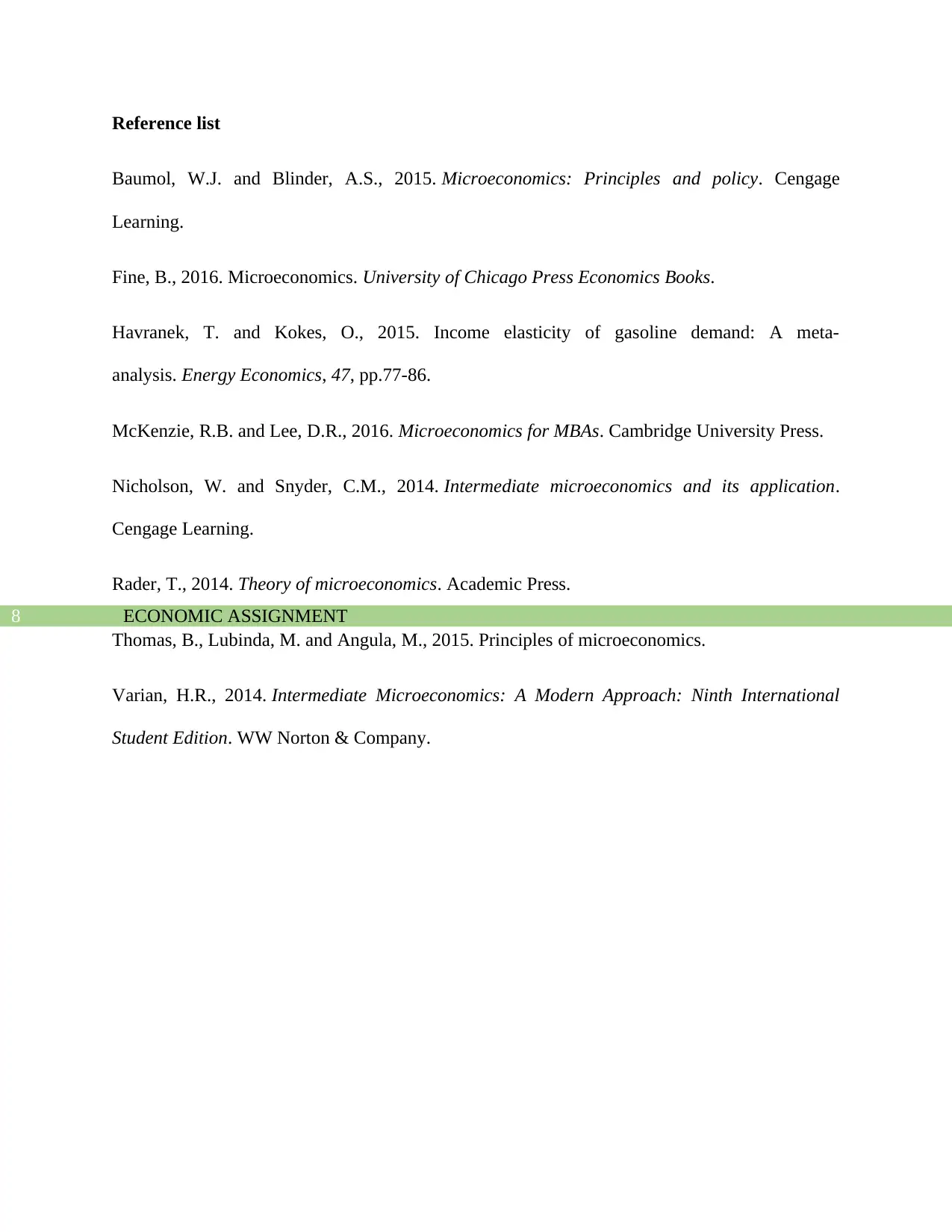
ECONOMIC ASSIGNMENT8
Reference list
Baumol, W.J. and Blinder, A.S., 2015. Microeconomics: Principles and policy. Cengage
Learning.
Fine, B., 2016. Microeconomics. University of Chicago Press Economics Books.
Havranek, T. and Kokes, O., 2015. Income elasticity of gasoline demand: A meta-
analysis. Energy Economics, 47, pp.77-86.
McKenzie, R.B. and Lee, D.R., 2016. Microeconomics for MBAs. Cambridge University Press.
Nicholson, W. and Snyder, C.M., 2014. Intermediate microeconomics and its application.
Cengage Learning.
Rader, T., 2014. Theory of microeconomics. Academic Press.
Thomas, B., Lubinda, M. and Angula, M., 2015. Principles of microeconomics.
Varian, H.R., 2014. Intermediate Microeconomics: A Modern Approach: Ninth International
Student Edition. WW Norton & Company.
Reference list
Baumol, W.J. and Blinder, A.S., 2015. Microeconomics: Principles and policy. Cengage
Learning.
Fine, B., 2016. Microeconomics. University of Chicago Press Economics Books.
Havranek, T. and Kokes, O., 2015. Income elasticity of gasoline demand: A meta-
analysis. Energy Economics, 47, pp.77-86.
McKenzie, R.B. and Lee, D.R., 2016. Microeconomics for MBAs. Cambridge University Press.
Nicholson, W. and Snyder, C.M., 2014. Intermediate microeconomics and its application.
Cengage Learning.
Rader, T., 2014. Theory of microeconomics. Academic Press.
Thomas, B., Lubinda, M. and Angula, M., 2015. Principles of microeconomics.
Varian, H.R., 2014. Intermediate Microeconomics: A Modern Approach: Ninth International
Student Edition. WW Norton & Company.
⊘ This is a preview!⊘
Do you want full access?
Subscribe today to unlock all pages.

Trusted by 1+ million students worldwide
1 out of 9
Related Documents
Your All-in-One AI-Powered Toolkit for Academic Success.
+13062052269
info@desklib.com
Available 24*7 on WhatsApp / Email
![[object Object]](/_next/static/media/star-bottom.7253800d.svg)
Unlock your academic potential
Copyright © 2020–2025 A2Z Services. All Rights Reserved. Developed and managed by ZUCOL.





